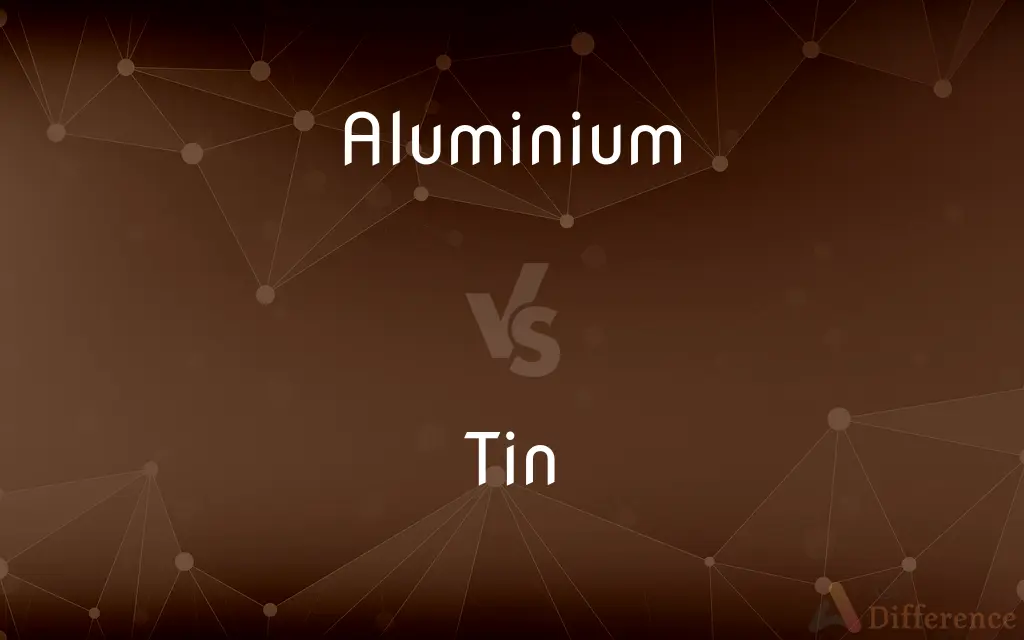Aluminium vs. Tin — What's the Difference?

Difference Between Aluminium and Tin
ADVERTISEMENT
Compare with Definitions
Aluminium
Variant of aluminum.
Tin
Tin is a chemical element with the symbol Sn (from Latin: stannum) and atomic number 50. Tin is a silvery metal that characteristically has a faint yellow hue.
Aluminium
A light, silvery metal extracted from bauxite, and a chemical element (symbol Al) with an atomic number of 13.
Tin
Symbol Sn A crystalline, silvery metallic element obtained chiefly from cassiterite, and having two notable allotropic forms. Malleable white tin is the useful allotrope, but at temperatures below 13.2°C it slowly converts to the brittle gray allotrope. Tin is used to coat other metals to prevent corrosion and is a part of numerous alloys, such as soft solder, pewter, type metal, and bronze. Atomic number 50; atomic weight 118.71; melting point 231.93°C; boiling point 2,602°C; specific gravity (gray) 5.77, (white) 7.29; valence 2, 4. See Periodic Table.
Aluminium
(countable) A single atom of this element.
ADVERTISEMENT
Tin
Tin plate.
Aluminium
(slang) Aircraft or other machinery made partially or wholly of aluminium.
Tin
A container or box made of tin plate.
Aluminium
Same as aluminum, chiefly British in usage.
Tin
A container for preserved foodstuffs; a can.
Aluminium
A silvery ductile metallic element found primarily in bauxite
Tin
The contents of such a container.
Tin
To plate or coat with tin.
Tin
Chiefly British To preserve or pack in tins; can.
Tin
Of, relating to, or made of tin.
Tin
Constructed of inferior material.
Tin
Spurious.
Tin
(uncountable) A malleable, ductile, metallic element, resistant to corrosion, with atomic number 50 and symbol Sn.
Tin
An airtight container, made of tin or another metal, used to preserve food, or hold a liquid or some other product.
A tin of baked beans; a tobacco tin; a tin of shoe polish
Empty tins, cans, and plastic containers are recycled in the blue bins.
Tin
(countable) A metal pan used for baking, roasting, etc.
Muffin tin
Roasting tin
Baking tin
Tin
The bottom part of the front wall, which is "out" if a player strikes it with the ball.
Tin
Money, especially silver money.
Tin
Computer hardware.
Tin
Made of tin.
Tin
Made of galvanised iron or built of corrugated iron.
Tin
(transitive) To place into a metal can (ie. a tin; be it tin, steel, aluminum) in order to preserve.
Tin
(transitive) To cover with tin.
Tin
(transitive) To coat with solder
Tin
To coat with solder, in preparation for soldering, to ensure a good solder joint
Tin
To coat with solder, in order to consolidate braided wire, so as to make contact with all strands and reduce fragility of the fraying wire
Tin
An elementary substance found as an oxide in the mineral cassiterite, and reduced as a soft silvery-white crystalline metal, with a tinge of yellowish-blue, and a high luster. It is malleable at ordinary temperatures, but brittle when heated. It is softer than gold and can be beaten out into very thin strips called tinfoil. It is ductile at 2120, when it can be drawn out into wire which is not very tenacious; it melts at 4420, and at a higher temperature burns with a brilliant white light. Air and moisture act on tin very slightly. The peculiar properties of tin, especially its malleability, its brilliancy and the slowness with which it rusts make it very serviceable. With other metals it forms valuable alloys, as bronze, gun metal, bell metal, pewter and solder. It is not easily oxidized in the air, and is used chiefly to coat iron to protect it from rusting, in the form of tin foil with mercury to form the reflective surface of mirrors, and in solder, bronze, speculum metal, and other alloys. Its compounds are designated as stannous, or stannic. Symbol Sn (Stannum). Atomic weight 117.4.
Tin
Thin plates of iron covered with tin; tin plate.
Tin
Money.
Tin
To cover with tin or tinned iron, or to overlay with tin foil.
Tin
A silvery malleable metallic element that resists corrosion; used in many alloys and to coat other metals to prevent corrosion; obtained chiefly from cassiterite where it occurs as tin oxide
Tin
Metal container for storing dry foods such as tea or flour
Tin
Airtight sealed metal container for food or drink or paint etc.
Tin
Plate with tin
Tin
Preserve in a can or tin;
Tinned foods are not very tasty
Tin
Prepare (a metal) for soldering or brazing by applying a thin layer of solder to the surface
Share Your Discovery

Previous Comparison
Drama vs. Novel
Next Comparison
Ketone vs. Aldehyde















































